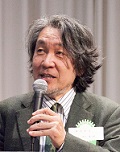��Water and Sanitation Month��
Edo / Tokyo –Water Metropolis
March 7, 2018
Ph.D. Hidenobu Jinnai
Professor, Faculty of Engineering and Design,
Hosei University
�� Tokyo was once a ��water metropolis�� from the Edo era up to the pre-war period. Unfortunately, water was polluted during the post-war high economic growth period and people paid little attention to waterfronts. Today I strongly feel that people have come to revisit the history of Edo/Tokyo focusing on the environmental issues and a symbiotic relationship between nature and humans.
Tokyo was once a ��water metropolis�� from the Edo era up to the pre-war period. Unfortunately, water was polluted during the post-war high economic growth period and people paid little attention to waterfronts. Today I strongly feel that people have come to revisit the history of Edo/Tokyo focusing on the environmental issues and a symbiotic relationship between nature and humans.
��A map of Edo drawn around 1640 shows the Edo Castle in the center surrounded by the inner and outer moats and a number of canals in downtown areas. The entire city of Edo was built to form a circular waterway around the Castle by making elaborate calculations of the unevenness of terrain and the flow of water. Waterfront areas played an important role in urban planning back then. It is no surprise that 80% of the scenes drawn in ��100 Famous Views of Edo�� by a renowned ukiyo-e artist Hiroshige Utagawa showed beautiful waterfront areas. Ieyasa Tokugawa, the founder and first shōgun of the Tokugawa shōgunate, was surely a far-sighted urban planner who excelled in building an efficient water network.
��Rivers and canals served as essential distribution routes to sustain the daily needs of 1 million inhabitants in Edo. Large sailing vessels loaded with supplies from Kansai area anchored off the coast of Tsukudajima and small wherries transported the goods through canals to warehouses. Interestingly enough, fishery flourished in Edo as fishing villages dotted near the city center and the shōgunate granted exclusive privilege for fishing. Waterfront areas also served as lively entertainment centers where theaters, bathhouses, teahouses and luxurious traditional Japanese restaurants attracted wealthy pleasure-seekers. Cultural activities were closely linked to waterfront and waterways in Tokyo, making it a very unique city in the world. I hope with the latest technology, aesthetic taste and capacity, we will unlock the potential of Tokyo once again as the ��water metropolis��.
��The collapse of the Tokugawa shōgunate opened the door to Japan��s modernization. A stylish Venetian Gothic style residence of Eiichi Shibusawa, a renowned entrepreneur and business leader of the Meiji era, was built along the Nihonbashi River, designed by architect Kingo Tatsuno who also designed Tokyo Station. Many young architects, artists and literary scholars were inspired and influenced by Western culture and the area became the epicenter of the ��civilization and enlightenment�� movement. Unfortunately, the Great Kanto Earthquake of 1923 caused devastating damages to Tokyo but the reconstruction work succeeded in reviving the waterfront area with modern design bridges and structures, parks and walking trails.
��After WWII, Japan enjoyed a miraculous economic growth from the mid-1950s towards the 1964 Tokyo Olympics. Unfortunately, such a rapid development triggered degradation of the water quality and people started to turn their backs on waterfront areas. But by the late 1970s, various events were revived along the Sumida River including the famous Fireworks Festival and propelled redevelopment of the bay area as fashionable cultural center, high-rise office building zone and later, as residential areas with modern condominiums.
��Tokyo as a whole is a ��water metropolis��. The old map indicates rivers and waterways run through the extended areas of Musashino and Tama. For example, Tamagawa Waterworks took water from the upper Tama River, which flowed eastward and finally reached the outer moat of the Edo Castle, providing water for human consumption as well as for agricultural use. Stable water supplies enhanced economic growth and social development in rural areas. Extensive water supply networks have made Tokyo a unique megacity with abundant greenery we find today in the heart of the metropolis, such as the Imperial Palace, State Guesthouse and the Meiji Shrine.
��Today, different events are held across Japan to attract people to waterfront areas. A bi-annual festival is held along the canal in Tennozu, Shinagawa Ward and the first waterfront café opened on the bank of the Sumida River. Waterfront areas have attracted people as early as the Edo era but today, new design and ideas create fashionable and trendy neighborhoods
In the bay area, many reclaimed lands that resemble islands form an ��archipelago��. Most of the sports stadiums and grounds will be concentrated in this area for the 2020 Tokyo Olympic and Paralympic Games. I hope the Tokyo Metropolitan Government will make better use of water transport and bicycles towards the Olympics. By drawing up long-term plans based on a holistic perspective, I believe we can make the waterfront areas even more attractive. If people in Tokyo work in close collaboration with different civil activities, we can create a future water metropolis. People from around the world will come to enjoy the Tokyo Olympic and Paralympic Games. Let��s try to discover what makes Tokyo so attractive and worth visiting.